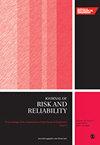Reliability analysis of PVD-coated carbide tools during high-speed machining of Inconel 800
IF 1.8
4区 工程技术
Q3 ENGINEERING, INDUSTRIAL
Proceedings of the Institution of Mechanical Engineers Part O-Journal of Risk and Reliability
Pub Date : 2024-03-04
DOI:10.1177/1748006x241235979
引用次数: 0
Abstract
Predicting the cutting tool life is crucial for effectively managing machining costs, ensuring product quality, maintaining equipment availability and minimising waste in machining processes. When machining heat-resistant superalloys such as Inconel, the concern for tool life becomes even more pronounced. Cutting tool failure is a complex phenomenon that depends on several variables, including tool type and material, workpiece material, machine tool type and machining parameters. Traditional run-to-fail tests to predict tool life are costly and time-consuming. To address these challenges, accelerated degradation testing (ADT) offers a promising solution. ADT involves subjecting the component to higher levels of parameters, causing it to fail faster than under normal conditions. This approach saves time and reduces expenses associated with tool life tests for valuable workpieces. In implementing the concept of ADT, the experimental cutting speed [Formula: see text] values are selected much higher than the normal usage levels in the present study. The tool life tests are performed at three levels of [Formula: see text], feed rate [Formula: see text], depth of cut [Formula: see text] and tool nose radius [Formula: see text] using the Taguchi L高速加工铬镍铁合金 800 时 PVD 涂层硬质合金刀具的可靠性分析
预测切削刀具寿命对于有效管理加工成本、确保产品质量、保持设备可用性和最大限度减少加工过程中的浪费至关重要。在加工 Inconel 等耐热超合金时,对刀具寿命的关注变得更加突出。切削刀具失效是一个复杂的现象,取决于多个变量,包括刀具类型和材料、工件材料、机床类型和加工参数。用于预测刀具寿命的传统失效测试既昂贵又耗时。为了应对这些挑战,加速降解测试(ADT)提供了一种很有前景的解决方案。ADT 是指将部件置于更高的参数水平下,使其比正常条件下的失效速度更快。这种方法节省了时间,降低了对贵重工件进行工具寿命测试的相关费用。在实施 ADT 概念时,本研究选择的实验切削速度[公式:见正文]值远远高于正常使用水平。使用田口 L9 正交阵列,在[公式:见正文]、进给量[公式:见正文]、切削深度[公式:见正文]和刀尖半径[公式:见正文]三个水平上进行刀具寿命测试。参数统计方法,即加速失效时间(AFT)模型,采用分布,即 Weibull 分布、对数正态分布和对数-对数分布,根据预测变量分析切削刀具的可靠性。各种刀具磨损模式被视为刀具失效的标准。比较了各种拟合模型预测的切削工具平均失效时间(MTTF)。此外,在确保[计算公式:见正文]和[计算公式:见正文]值在推荐范围内的情况下,使用中等水平的[计算公式:见正文]和在相对较高的[计算公式:见正文]值下工作时,可以观察到有利的刀具失效模式。所提出的方法具有多种应用潜力,包括评估切削工具的可靠性和工具状态监测。
本文章由计算机程序翻译,如有差异,请以英文原文为准。
求助全文
约1分钟内获得全文
求助全文
来源期刊

Proceedings of the Institution of Mechanical Engineers Part O-Journal of Risk and Reliability
ENGINEERING, MULTIDISCIPLINARY-ENGINEERING, INDUSTRIAL
CiteScore
4.50
自引率
19.00%
发文量
81
审稿时长
6-12 weeks
期刊介绍:
The Journal of Risk and Reliability is for researchers and practitioners who are involved in the field of risk analysis and reliability engineering. The remit of the Journal covers concepts, theories, principles, approaches, methods and models for the proper understanding, assessment, characterisation and management of the risk and reliability of engineering systems. The journal welcomes papers which are based on mathematical and probabilistic analysis, simulation and/or optimisation, as well as works highlighting conceptual and managerial issues. Papers that provide perspectives on current practices and methods, and how to improve these, are also welcome
 求助内容:
求助内容: 应助结果提醒方式:
应助结果提醒方式:


